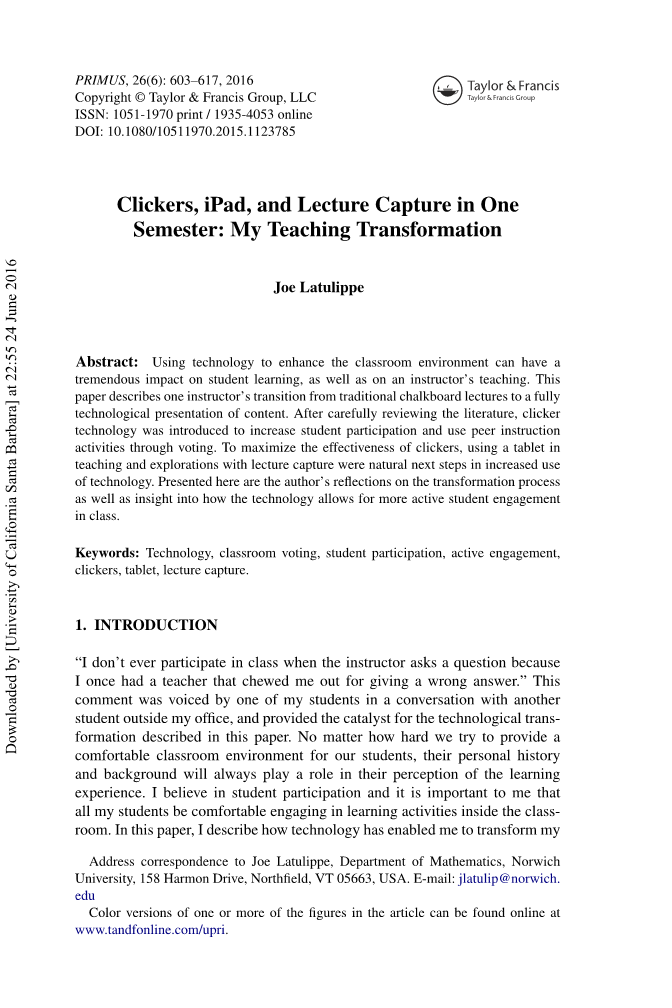

英语原文共 16 页,剩余内容已隐藏,支付完成后下载完整资料
Abstract: Using technology to enhance the classroom environment can have a tremendous impact on student learning, as well as on an instructorrsquo;s teaching. This paperdescribesoneinstructorrsquo;stransitionfromtraditionalchalkboardlecturestoafully technological presentation of content. After carefully reviewing the literature, clicker technology was introduced to increase student participation and use peer instruction activities through voting. To maximize the effectiveness of clickers, using a tablet in teaching and explorations with lecture capture were natural next steps in increased use of technology. Presented here are the authorrsquo;s reflections on the transformation process as well as insight into how the technology allows for more active student engagement in class.
Keywords: Technology, classroom voting, student participation, active engagement, clickers, tablet, lecture capture.
1. INTRODUCTION
“I donrsquo;t ever participate in class when the instructor asks a question because I once had a teacher that chewed me out for giving a wrong answer.” This comment was voiced by one of my students in a conversation with another student outside my office, and provided the catalyst for the technological transformation described in this paper. No matter how hard we try to provide a comfortable classroom environment for our students, their personal history and background will always play a role in their perception of the learning experience. I believe in student participation and it is important to me that all my students be comfortable engaging in learning activities inside the classroom. In this paper, I describe how technology has enabled me to transform me
Address correspondence to Joe Latulippe, Department of Mathematics, Norwich University, 158 Harmon Drive, Northfield, VT 05663, USA. E-mail: jlatulip@norwich. edu Color versions of one or more of the figures in the article can be found online at www.tandfonline.com/upri.
Downloaded by [University of California Santa Barbara] at 22:55 24 June 2016
classroom environment to increase student participation and allow students to actively engage with the material. This paperrsquo;s primary goal is to provide the reader with information on how to make a transition from traditional lectures to a face-to-face classroom where the course content, discussion points, and student problem break carefully integrated technologically. A thorough examination of the literature on clickers is included in order to illustrate their usefulness in generating student participation and peer-to-peer discussion. Using classroom voting, clickers were the starting point for my own technological transformation. Through the lens of my Calculus courses, the reader will be guided through information on peer instruction and clickers, lecturing using an iPad, and using lecture capture.
2. CLASSROOM VOTING AND TEACHING WITH TECHNOLOGY
2.1. Background on Classroom Voting
SinceEricMazurdescribedhisclassroomvotingtechniqueinPeerInstruction: A Userrsquo;s Manual [21], classroom voting has been well-documented as a pedagogical practice [2, 3, 8, 9, 12, 13, 25]. Whether through peer instruction or some other method, students generally have a positive attitude toward classroom voting [5, 30]. In the process of voting, students read a question, assess the task to be done, determine a solution, and commit to an answer, thus actively engaging with the content. In addition, many instructors offer students the opportunity to discuss their results with other students at some point in the voting process. Sometimes described as think–pair–share [20], students first think about the problem, pair up or form groups, and then share how they arrived at their results. Thus, the voting process can also create an opportunity for students to collaborate with their peers and communicate with them about mathematics during class. Classroom voting can take many forms, including low-technology techniques such as a simple show of hands, color-coded cards, or some other variant that allows students to show their response to a question. Although these voting methods can be implemented to provide some anonymity for students, full anonymity cannot be guaranteed; it can also be cumbersome for the instructor to count and tally responses by hand. The alternative, a higher-technology voting method such as the use of Personal Response Systems, or clickers, has been growing around the globe and has resulted in a number of books being published on using clickers such as Bruffrsquo;s Teaching with Classroom Response Systems: Creating Active Learning Environments [5] and Cline and Zullorsquo;s Teaching Mathematics with Classroom Voting, With and Without Clickers [12]. In fact, some studies suggest that using clickers along with peer instruction can improve student exam scores [1, 17, 22, 24]. Workshops and trainings on their use are now regularly featured at national and regional conferences.
One of the main advantages for using clickers is that students can give anonymous answers without worry of humiliatio
剩余内容已隐藏,支付完成后下载完整资料
资料编号:[261325],资料为PDF文档或Word文档,PDF文档可免费转换为Word


